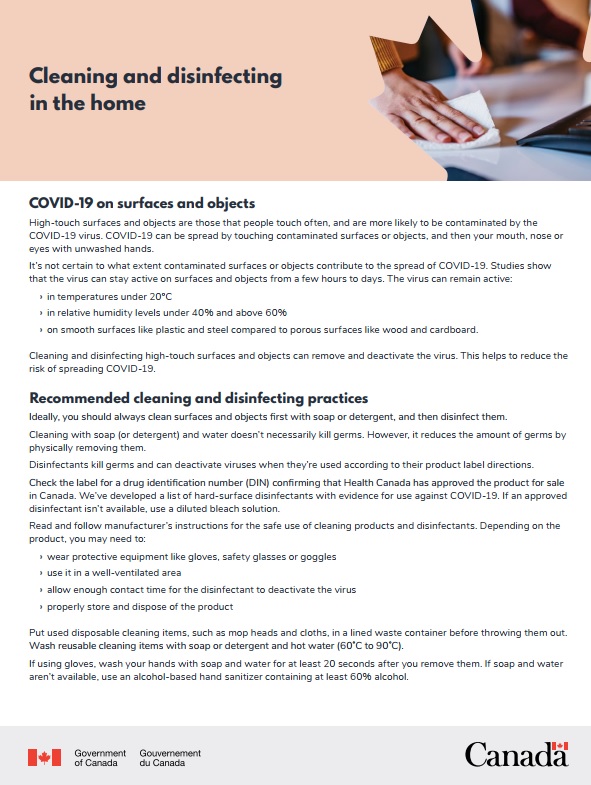COVID-19: Cleaning and disinfecting in the home
Download in PDF format
(116 KB, 2 pages)
Please select a language:
Organization: Public Health Agency of Canada
Published: 2022-07-18
Related links
COVID-19 on surfaces and objects
High-touch surfaces and objects are those that people touch often, and are more likely to be contaminated by the COVID-19 virus. COVID-19 can be spread by touching contaminated surfaces or objects, and then your mouth, nose or eyes with unwashed hands.
It's not certain to what extent contaminated surfaces or objects contribute to the spread of COVID-19. Studies show that the virus can stay active on surfaces and objects from a few hours to days. The virus can remain active longer:
- in temperatures under 20° C
- in relative humidity levels under 40% and above 60%
- on smooth surfaces like plastic and steel compared to porous surfaces like wood and cardboard
Cleaning and disinfecting high-touch surfaces and objects can remove and deactivate the virus. This helps to reduce the risk of spreading COVID-19.
Recommended cleaning and disinfecting practices
Ideally, you should always clean surfaces and objects first with soap or detergent, and then disinfect them.
Cleaning with soap (or detergent) and water doesn't kill germs. However, it reduces the amount of germs by physically removing them.
Disinfectants kill germs and can deactivate viruses when they're used according to their product label directions.
Check the label for a drug identification number (DIN) confirming that Health Canada has approved the product for sale in Canada. We've developed a list of hard-surface disinfectants with evidence for use against COVID-19. If an approved disinfectant isn't available, use a diluted bleach solution.
Read and follow manufacturer's instructions for the safe use of cleaning products and disinfectants. Depending on the product, you may need to:
- wear protective equipment like gloves, safety glasses or goggles
- use it in a well-ventilated area
- allow enough contact time for the disinfectant to deactivate the virus
- properly store and dispose of the product
Put used disposable cleaning items, such as mop heads and cloths, in a lined waste container before throwing them out. Wash reusable cleaning items with soap or detergent and hot water (60° C to 90° C).
If using gloves, wash your hands with soap and water for at least 20 seconds after you remove them. If soap and water aren't available, use an alcohol-based hand sanitizer containing at least 60% alcohol.
Cleaning and disinfecting in your home
Regularly clean and disinfect high-touch surfaces and objects in your home. This is especially important when they're visibly dirty or when someone's sick.
High-touch surfaces and objects in your home may include:
- toys
- toilets
- light switches
- laundry hampers
- tables and countertops
- phones, television remotes and electronics
- door handles, doorknobs, refrigerators, dishwashers, cabinets and faucets
When someone has or may have COVID-19 in your home
Clean and disinfect high-touch surfaces and objects in your home more frequently to reduce the risk of transmission. This is especially important if someone in the home is at risk of more severe disease or outcomes from COVID-19.
Regularly clean and disinfect spaces the person who has or may have COVID-19 has used, like sleeping areas and washrooms. While cleaning and disinfecting, wear the best quality and best fitting respirator or mask that's available to you.
You can wash contaminated and soiled laundry, including reusable masks, with other laundry. When washing, you should:
- put laundry directly into the washing machine, or into a lined container if it's not being washed right away
- wash laundry using a hot cycle (60° C to 90° C) with laundry soap or detergent
- if a washing machine is unavailable, wash thoroughly by hand using soap and hot water
- dry laundry well
Wash your hands as soon as you finish handling contaminated laundry.
